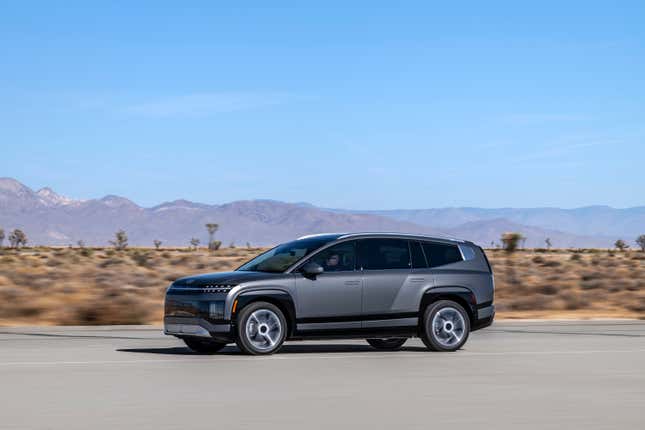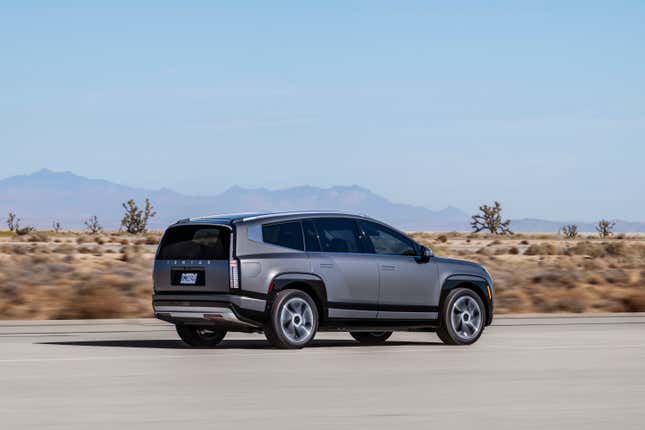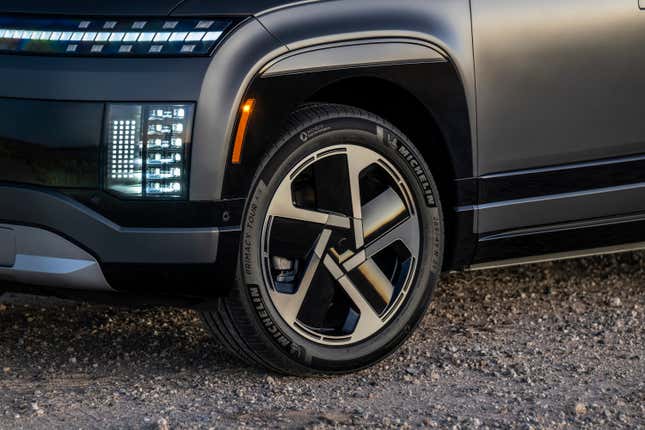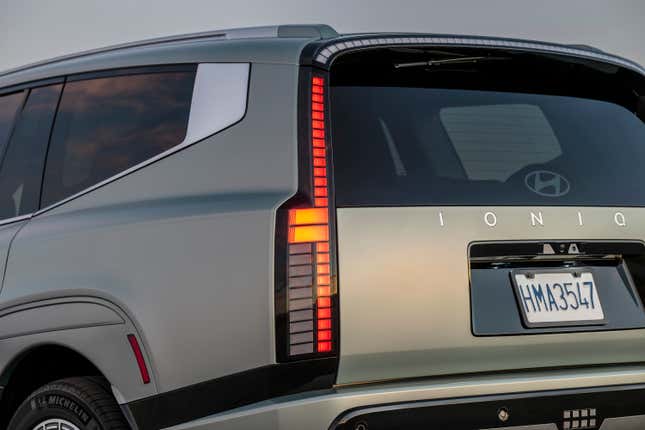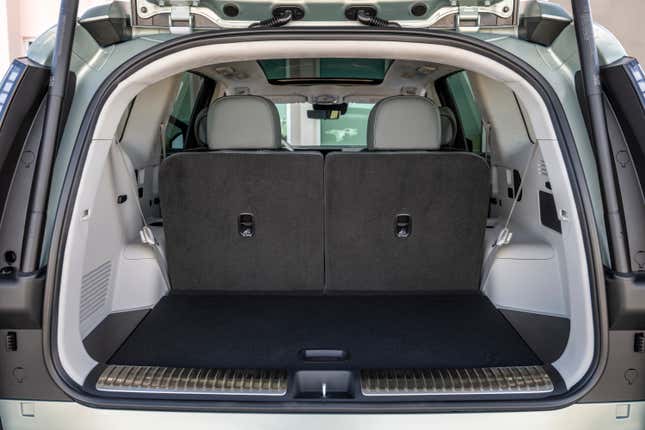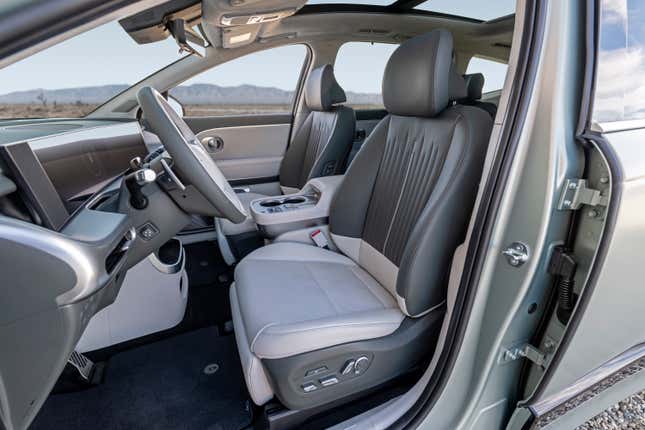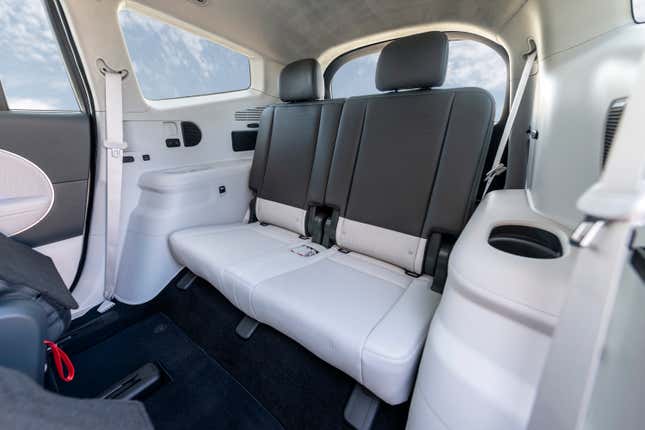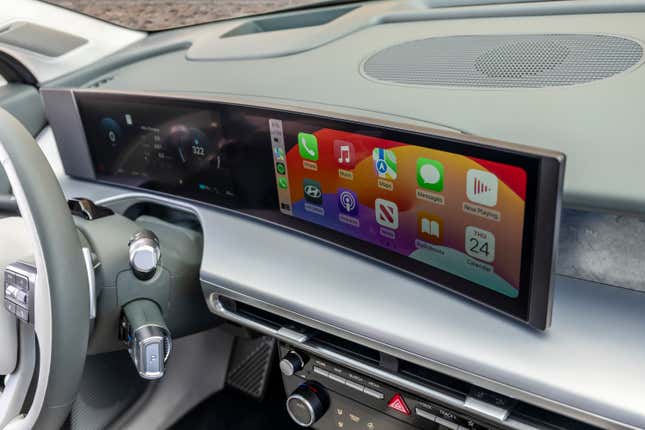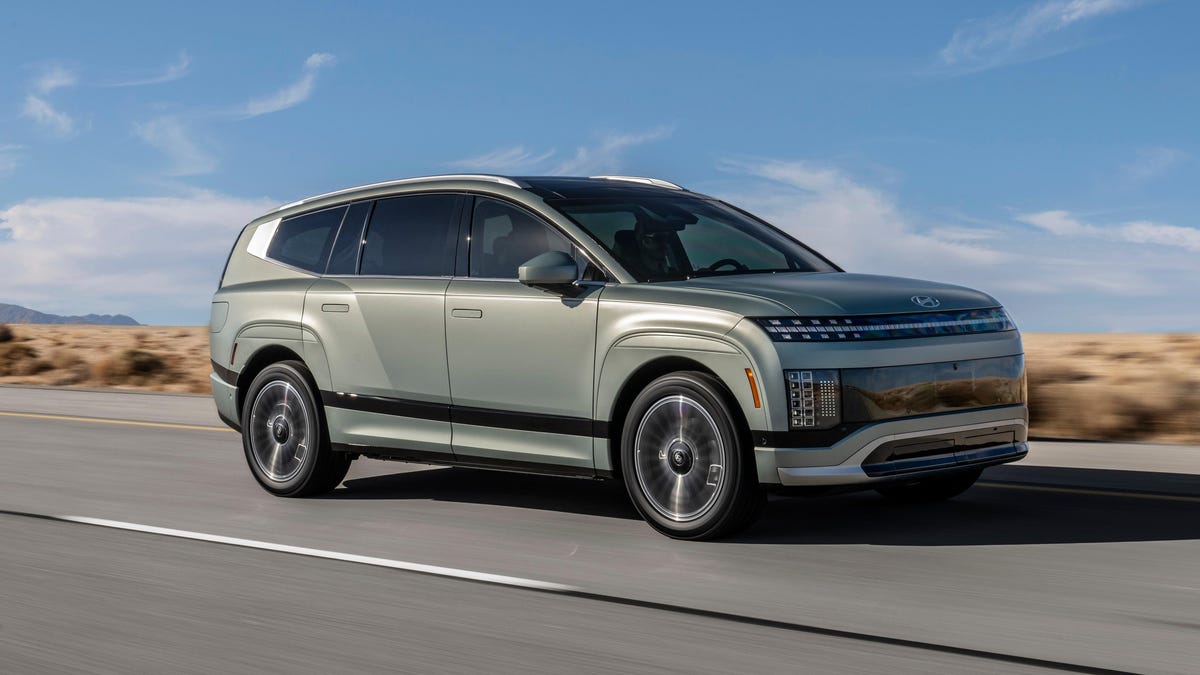Three years after unveiling its Seven concept at the Los Angeles Auto Show, Hyundai is using that same show to debut the production 2026 Ioniq 9, a large three-row SUV that’s a sibling to Kia’s EV9. (The name was changed from 7 to 9 to leave room for more future Ioniq models.) It’s a wild-looking thing, with even wackier styling than the concept that helps it efficiently glide through the air. Hyundai describes the Ioniq 9 as being aimed at consumers who value space, privacy and relaxation.
Like nearly all of Hyundai Motor Group’s new EVs, the Ioniq 9 rides on the modular E-GMP platform, with some new upgrades. Every version of the Ioniq 9 has a 110.3-kWh battery pack mounted in the floor, powering either a single electric motor at the rear axle or a pair of motors, one for each axle. The base Long Range rear-wheel-drive model makes 215 horsepower and 258 pound-feet of torque, good enough to go from 0 to 60 mph in 8.4 seconds. Opting for the Long Range AWD trim adds a 94-hp motor to the front axle for a total of 303 hp, bringing the 0-60 time down to 6.2 seconds, while the highest-end Performance AWD trim has a larger front motor that ups output to 422 hp and has a 4.9-second 0-to-60 time. All-wheel-drive Ioniq 9s can tow up to 5,000 pounds, while the RWD one can pull 3,500 pounds.
No matter what version of the Ioniq 9 you go for, it’ll have an EPA range of at least 300 miles. For maximum range you’ll want a RWD Ioniq 9 with 19-inch wheels, which will have a 335-mile range, but even the Performance AWD model with 21s will hit the magic 300-mile mark, something Kia can’t say for the EV9. Like the facelifted Ioniq 5, the Ioniq 9 will have the Tesla-style NACS charger at launch. Hyundai says you’ll be able to charge from 10 to 80 percent in 24 minutes when using a 350-kW charger, and the Ioniq 9 will have vehicle-to-load capabilities.
You have the Ioniq 9’s design to thank for those range figures. Hyundai says the Ioniq 9 has a drag coefficient of 0.269 (or 0.259 with the camera mirrors we don’t get in the U.S.), which is impressive for such a big vehicle — as a point of comparison, the Hyundai Palisade has a 0.33 drag coefficient, while the smaller and much less spacious Tesla Model X has a 0.24 figure. A lot of the Ioniq 9’s aerodynamic prowess has to do with its swept-back windshield and streamlined roofline that manages to still include roof rails and do without any sort of spoiler, plus new active air flaps, a specially shaped underbody, hidden antennas and optimized wheel designs. In a first for Hyundai the Ioniq 9 has aluminum fenders and quarter panels, which reduce weight and in turn further improves its efficiency.
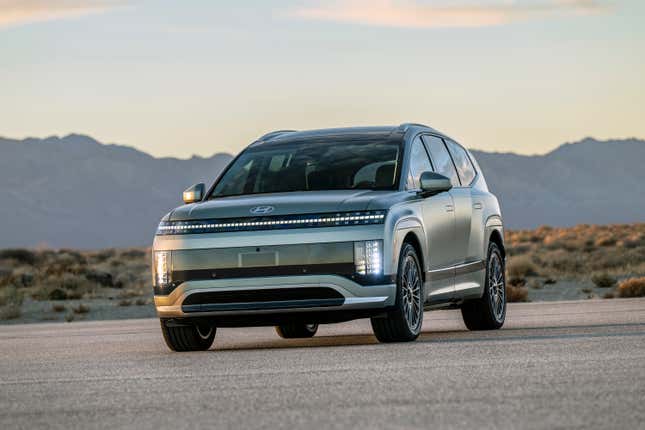
Beyond just how aerodynamic it is, I think the Ioniq 9 is a standout design in the segment. It looks like a happy robot from the front, with a wide pixel light bar stretching across the nose and tall banks of pixel lights in the bumper acting as the main headlights, and instead of a grille there’s a dark translucent panel hiding sensors and cameras. The fender flares give the illusion of squared-off wheel openings, finished in black on regular models with body-color inserts, while the Calligraphy gets all of the cladding in body color — Hyundai says these fender flares could be replaced with wider units on future off-road or performance models.
The rear haunch features a “Hanbok Line” inspired by the collar of traditional Korean dresses, and along with the subtly flared arches and tapered roofline, it gives the illusion of a much wider body. I love how the window trim kicks up at the D-pillar to form the design of the roof rails, and all of the glass is super flush. The rear end is the Ioniq 9’s standout design element, with pixel lights that wrap around the tailgate like an arch and tapered-in glass that creates a spoiler lip hiding the rear wiper. The Ioniq 9’s design definitely won’t be for everyone, but it’s absolutely for me.
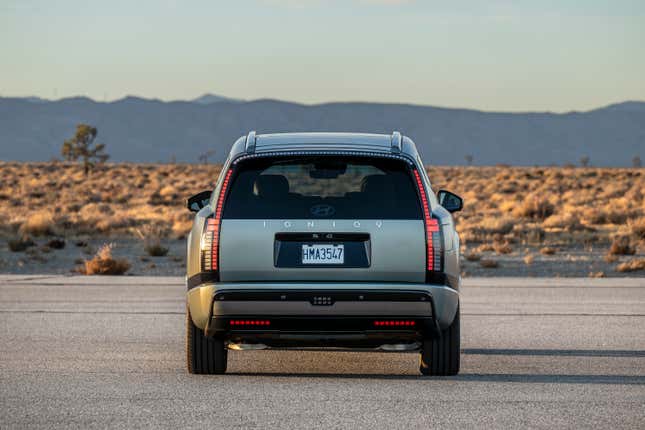
Despite that sloping roofline, there is a gigantic amount of space inside, which is really what’s important in a three-row crossover. The Ioniq 9 is 199.2 inches long overall, nearly identical to the Model X, but its 123.2-inch wheelbase is 6.5 inches longer than the Tesla (and more than an inch longer than the EV9’s). It has more second- and third-row headroom and legroom than the Kia as well. You’ll be able to get the Ioniq 9 with either a three-across bench seat or a pair of captain’s chairs in the second row, and the middle and back rows can both be power-folded up and down via controls in the cargo area. The second-row seats have a one-touch folding setup that makes it super easy to climb into the way back. With the third row of seats in place the Ioniq 9 has 21.9 cubic feet of cargo space, and folding the third row opens that up to 46.7 cubic feet, both of which put it at the top of the segment. You get up to 3.1 cubic feet of space in the frunk, too.
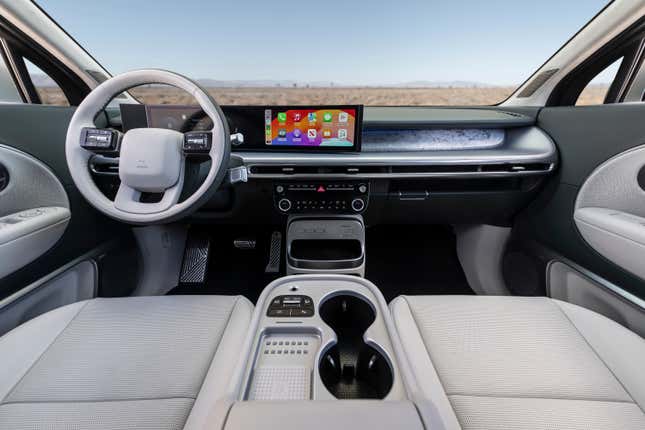
The interior design isn’t as radical as that of the outside, but there are a bunch of cool elements, like the pill-shaped door card designs that have nice textures and soft ambient lighting. A large curved screen combines the 12-inch gauge cluster and 12-inch central touchscreens, and there are a bunch of physical buttons and knobs for the climate controls, sound system and other frequently used items. There are a bunch of storage shelves and trays and tons of high-powered USB-C ports throughout, In top Calligraphy trim the Ioniq 9 feels quite luxurious, with recycled materials and interesting fabrics being put to good use.
In addition to front seats that have a relaxation mode with integrated leg rests like on the Ioniq 5, the second-row captain’s chairs recline super far back and have their own leg rests, and they can be lined up with a laid-back front seat for a truly lounge-like experience. (They also get a massage function, thank god.) The Universal Island center console can be slid back seven and a half inches for easier access by the second row, and it has multiple deep storage cubbies that can be opened from the front or the back. Sadly, the U.S. won’t get the Ioniq 9’s second-row seats that can swivel to face the third row. Blame our pesky safety regulations for that. If you want to relax while charging or waiting for your kids’ soccer game to let out, or if you want to do some in-car camping, the Ioniq 9’s climate control system can only run in the rear of the car, saving you energy.
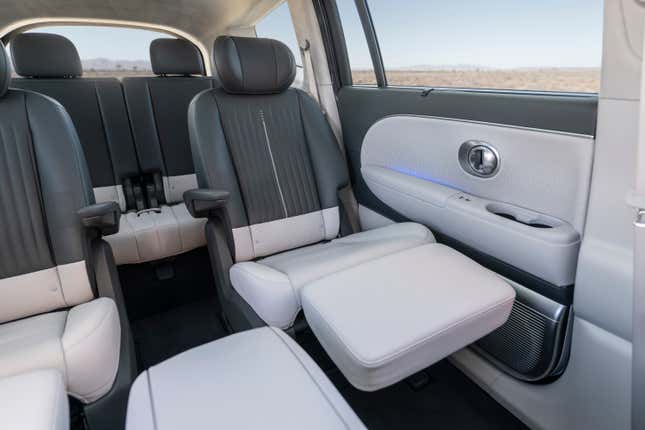
Other tech features include over-the-air updates, a UV sterilizer for things like your phone or wallet, an improved EV route planner and trip info pages, an AI voice assistant, and an online store that will sell downloadable upgrades like new light signatures and media streaming apps — don’t worry, Hyundai won’t be charging subscription fees for things like heated seats. An optional 14-speaker Bose system has active sound deadening by using sensors in the wheel wells that sense noise and vibration. The Ioniq 9 also has every safety feature you can think of both active and passive, including a new rear-seat monitor that can detect the breathing of a sleeping baby underneath a blanket.
The 2026 Hyundai Ioniq 9 will enter production in the U.S. in the first half of 2025 at the company’s plant in Georgia, going on sale shortly thereafter. We don’t have any word on pricing yet, but a starting MSRP in the low-$50,000 range seems like a safe bet. Hyundai says it expects the Ioniq 9 will qualify for the full $7,500 federal tax credit, as long as that’s still a thing by then.
